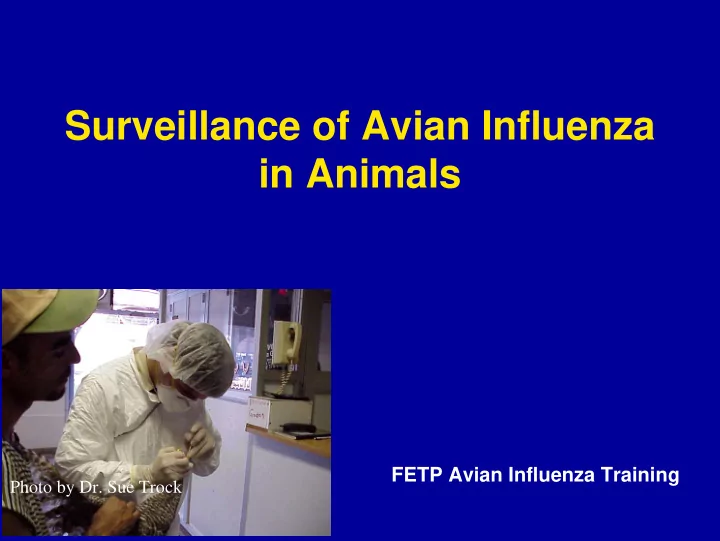

Surveillance of Avian Influenza in Animals FETP Avian Influenza Training Photo by Dr. Sue Trock
Learning Objectives • Describe surveillance methods for avian influenza in birds and other animals • Describe the difference in surveillance methods recommended – dependent on vaccination status of animals – based on pandemic phase
Surveillance Methods for AI Animals
Goals of AI Surveillance in Commercial Poultry • Early detection of AI infections – Prevent costly outbreaks – Concerns about introduction of foreign poultry disease (unintentional or intentional) • Assure that commercial poultry is free of AI infection for trade purposes – Transparency – Assure continued market access • Instill consumer confidence in poultry and poultry products as it relates to public health
Goals of AI Surveillance in Commercial Poultry • Accomplished through… – Passive and Active Surveillance
Passive Surveillance in Commercial Poultry • Investigation of clinical cases or flocks with production drops or respiratory disease – LPAI – HPAI • Diagnostic methods – Antibody detection – Virus/RNA detection
Outbreak and Surveillance Outbreak and Surveillance Outbreak and Surveillance Affected Zone Surveillance Zone Buffer Zone
Active Surveillance in Commercial Poultry • Organized random testing to detect infection • Diagnostic methods – Antibody detection – Virus/RNA detection • Source of samples – Testing at slaughter/processing – serum, eggs – Testing of exhibition birds – Export testing
Diagnostic Tests (Antibody) • Type-specific tests (type A) – Agar gel immunodiffusion (AGID) test – Enzyme-linked immunosorbent assay (ELISA) – Detect antibodies to all subtypes of flu virus – Performed at state/university/industry labs • Subtype-specific tests (H and N subtypes) – Hemagglutination-inhibition (HI) test – Neuraminidase-inhibition (NI) tests – Performed by reference labs (NVSL)
Diagnostic Tests (Virus) • Virus isolation (embryonating chicken eggs) – Gold standard • Real-time RT-PCR – Matrix primers (detects all subtypes) – H5 and H7 specific primers • Antigen capture ELISA (e.g. Directigen) – Most useful for clinical or dead birds (acute infection)
Integrating Animal and Human Influenza Surveillance • Big challenge for almost every country • Better integration is essential for preparing for threats to human health • Need to encourage studies at the human/animal and wild bird/domestic bird interfaces • Need to improve global ability to identify viruses of all subtypes
WHO/OIE Reporting • Member states of OIE are to report within 24 hours suspected or confirmed cases of HPAI outbreaks in animals • OIE – publishes formal communications on outbreaks through its website – issues press releases about established outbreaks in animals OIE Website: http://www.oie.int/
Proposed WHO Animal Influenza Network • Proposed to be an informal program to bring together information from various animal influenza surveillance systems – Clinical outbreaks investigated by diagnostic laboratories – Wildlife outbreaks investigated by wildlife disease groups – Systematic surveillance in lower animals and birds by research-based programmes
Differences Recommended Based on Vaccination Status
Unvaccinated vs. Vaccinated • Unvaccinated • Vaccinated – Detection is simple – Detection is more in that only infected difficult because birds will test vaccinated birds will positive have some antibodies or reactive proteins from the vaccine
Surveillance in Vaccinated Populations Surveillance strategy dependent on type of vaccine used: Haemagglutinin Inactivitated whole expression-based virus vaccines – Antibodies detected – Low titre of to specific HA but antibodies to NSP; not any other of the titre in infected birds viral proteins markedly higher
Using Sentinel Birds in Vaccinated Populations • Sentinel birds should be – Unvaccinated – AI virus antibody free – Clearly and permanently identified Vaccinated birds will only have either – antibodies to one of the specific proteins (but not all) or – low antibodies, so infection in sentinel birds in a vaccinated population can be detected.
Differences Recommended Based on Pandemic Phase
For Countries Free of Infection • Implement surveillance in higher risk sites – Borders and international entry points (particularly those adjacent to infected countries) – Domestic waterfowl – Unusual mortality in wild birds – Live bird markets • Vaccine usage has impact
Previously Infected Countries No vaccination • Surveillance should be targeted to the following high risk areas and populations : – Domestic waterfowl – Unusual mortality in wild birds – Live bird markets – Sentinel villages
Previously Infected Countries Practicing Vaccination • Ensure vaccinated birds achieve protective levels of immunity • Field viruses are detected and characterized
Resources • FAO Guiding Principles for Highly Pathogenic AI Surveillance and Diagnostic Networks In Asia • OIE Guidelines for the Surveillance of AI • WHO Guidelines for Global Surveillance of Influenza A/H5 • WHO Manual on Animal Influenza Diagnosis and Surveillance
Acknowledgements • United States Department of Agriculture (USDA) – David Swayne • U.S. CDC – Nina Marano – Thomas Gomez • FAO Guiding Principles for Highly Pathogenic AI Surveillance and Diagnostic Networks In Asia • OIE Guidelines for the Surveillance of AI • WHO Guidelines for Global Surveillance of Influenza A/H5
Recommend
More recommend